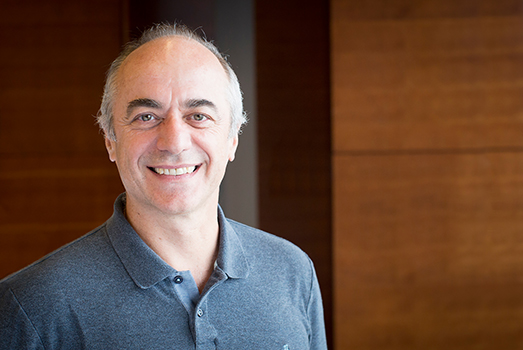KAUST and the promise of reinvention

J. Carlos Santamarina, Professor of Earth Science & Engineering (Physical Science and Engineering) <a href="http://egel.kaust.edu.sa/Pages/Home.aspx" target="_blank">Energy GeoEngineering Laboratory (EGEL)</a>.
J. Carlos Santamarina is Professor of Earth Science and Engineering in the Physical Science and Engineering Division and Associate Director of KAUST’s newly created Upstream Petroleum Engineering Research Center (UPERC). Before joining KAUST, Santamarina was a professor of civil and environmental engineering at the Georgia Institute of Technology (U.S.). He decided to join KAUST soon after he visited the University in the fall of 2014.
Santamarina’s research at KAUST explores the scientific foundations of geomaterial behavior and subsurface processes through the use of particle-level and pore-scale experiments combined with numerical methods and high-resolution process monitoring systems.
“Our research places emphasis on the fundamental understanding of geo-materials and the complexity of coupled thermo-hydro-bio-chemo-mechanically processes. Our approach is based on elegant experimental designs with extensive instrumentation and monitoring, and is complemented with simple but robust analytical solutions and numerical simulations,” he explained.
His conceptual and experimental framework is advancing the study of phenomena and the development of solutions in energy geo-engineering with contributions to resource recovery, including petroleum and methane hydrates; energy geo-storage; and the geological storage of energy waste, such as carbon geological storage, fly ash and nuclear waste.
The developing field of energy geo-engineering projects geotechnology into new dimensions to address energy sustainability on a global scale.
“Our field is going through dramatic changes today, with new insights, new lab devices and methodologies, new field and numerical tools, new physical concepts and new challenges on the horizon,” he said. “In particular geo-engineering is playing a central role in the global energy challenge – in fact, today’s young generation will live through one of the most fertile times in the history of geotechnical engineering.”
Nurturing a spark
Santamarina’s curiosity for science and problem solving was sparked and subsequently nurtured by his parents in his hometown of Cordoba, Argentina.
”My first mentors were my parents – they pushed me to do my best in all my activities and endeavors,” he noted.
As a child, Santamarina’s father gave him a book entitled “New UNESCO Source Book for Science Teaching.” The book kept him engaged for years, and he used it as a resource to carry out experiments involving bacteria, plants, ants, rocks, coils, distillation, freezing, surface tension and sound waves.
“The book was fascinating. In fact, our research today still benefits from the concepts and experimental approaches I learned from the book,” Santamarina said.
Santamarina believes that KAUST is the right place for the best academic time of his life.
“Here, we are primed to make meaningful scientific and engineering contributions. Furthermore, we have an unmatched environment to bolster an exceptional generation of world-bound and committed Ph.D.s and post-doctoral fellows,” he noted.
Like so many researchers and students at KAUST, he benefits greatly from the facilities and cutting-edge technology at hand. “My team and I have just started to explore the wide range of opportunities KAUST offers researchers, including analytical capabilities, the great machine shop, great field devices and our own living laboratory on our doorstep: the Red Sea,” he said.
A choice for reinvention
For Santamarina, coming to KAUST was a choice for reinvention.
“We live busy lives and we can readily fall into the beaten path. It takes concerted everyday effort to abstract ourselves from the system – both internal and external – in order to remain focused on exploring the new and seeking meaningful results,” he said. “It is important that we take the risk to reinvent ourselves to remain alive and passionate. The conditions here are exceptional. From an academic point of view, KAUST has unparalleled resources, world-renowned faculty with outstanding citation records and an unprecedented growth in reputation.”
Along with authoring two books and over 300 publications, Santamarina is also a member of both Argentinian National Academies of Science and Engineering and has served on multiple committees in the U.S. National Academies of Sciences, Engineering and Medicine. However, his greatest satisfaction does not lie with these achievements, but instead comes from the people he has worked with throughout his career.
“I am most proud of the amazing group of students and former team members I have had who are now thriving in their own careers,” he said. More than 30 of his former students are now accomplished academics at many of the world’s leading universities.
Santamarina describes KAUST “as a dream in the making.” He encourages his students to be curious and to seek understanding, and to live their academic lives as a vocation, not a profession. “You should have a dream and devote your heart and soul to making it happen,” he said.
- David Murphy, KAUST News

